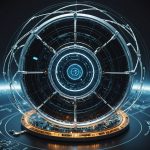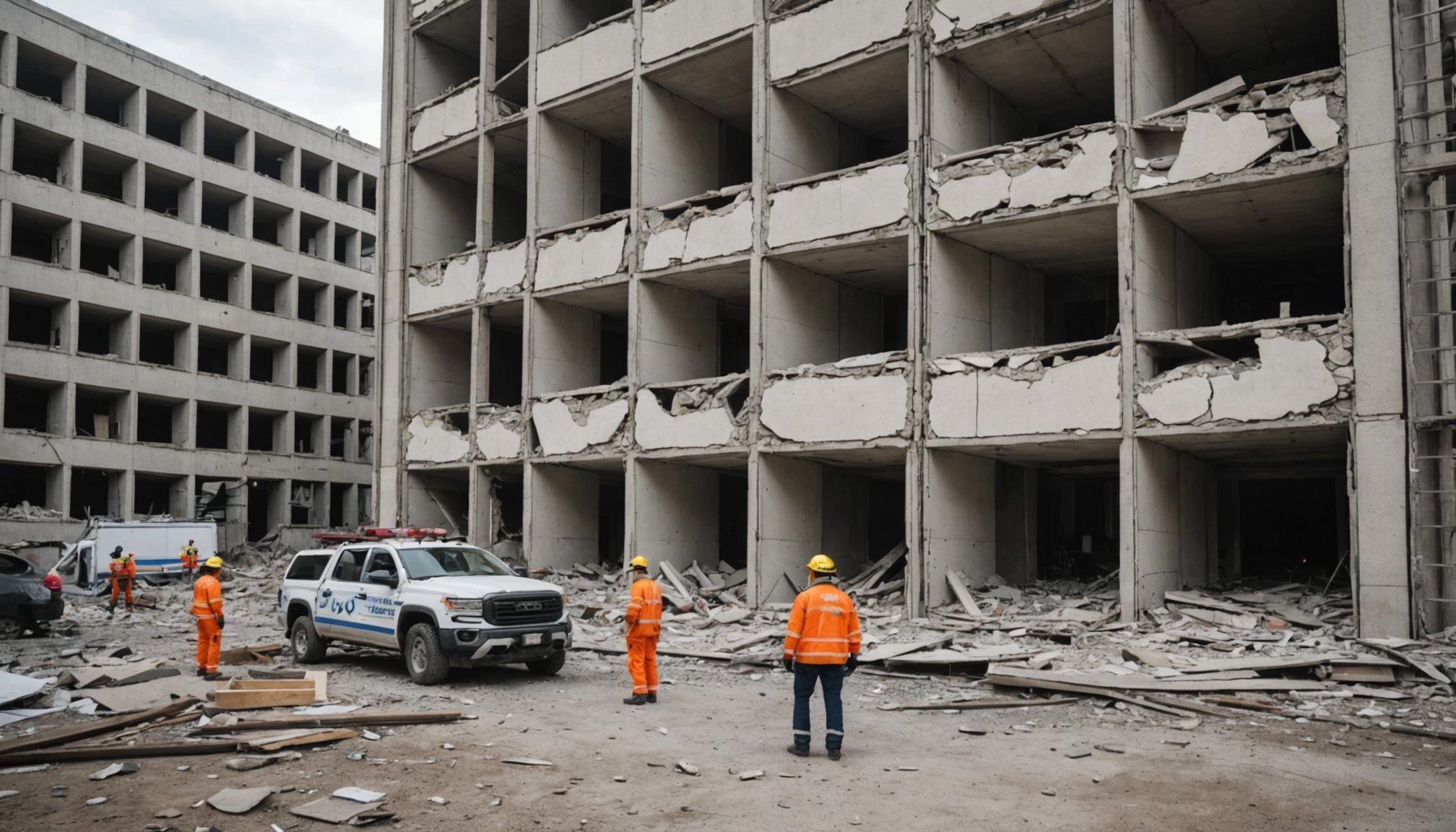Transforming Emergency Response: The Role of AI in Advanced Structural Damage Detection in Buildings
The Need for Advanced Structural Damage Detection
In the wake of natural disasters or structural failures, the ability to quickly and accurately assess the damage to buildings and infrastructure is crucial for effective disaster response and management. Traditional methods of inspection, while thorough, can be time-consuming, costly, and sometimes hazardous for the inspectors. This is where artificial intelligence (AI) steps in, revolutionizing the field of structural damage detection with its precision, speed, and predictive capabilities.
How AI-Powered Robots Inspect Buildings
AI-driven inspections are transforming the way we monitor and maintain building integrity. Researchers at Drexel University, for example, have developed a system that uses convolutional neural networks to recognize structural damage in concrete. Here’s how it works:
Also read : Unveiling the quantum internet revolution: future cybersecurity impacts you need to know
Machine Vision and Laser Scanning
When an AI-powered robot detects a crack, it uses a machine vision system combined with a laser scanner to measure the crack with high precision. This system can detect cracks as small as a hundredth of a millimeter, far surpassing the capabilities of conventional fiber-optic sensors and leading cameras[2].
Creating Digital Twins
The robot then uses lidar to scan the surrounding area and builds a digital twin of the damaged structure. This virtual replica allows building and architectural professionals to assess the condition of the crack in detail, including its potential impact on the structure’s integrity and how it may worsen over time. This predictive insight enables more informed decision-making and proactive maintenance[2].
In the same genre : Transforming public infrastructure: the impact of iot technology on monitoring and maintenance solutions
Predictive Insights and Decision Making
One of the key advantages of AI in structural damage detection is its ability to provide predictive insights. Here are some ways AI enhances decision making:
Early Detection and Prevention
Early detection of structural issues buys professionals more time to determine the best course of action. For instance, if a crack is detected early, teams can address it immediately to prevent larger failures. This proactive approach reduces the risk of sudden and catastrophic failures, ensuring the safety of occupants and the longevity of the structure[2].
Simulating Scenarios
AI-driven systems can simulate various scenarios to predict how a cracked structure would hold up to expected stresses. This capability takes the guesswork out of performance predictions, allowing for more accurate risk assessments and better-informed maintenance strategies.
Optimizing Construction Practices
By analyzing digital twins of several damaged supports, teams can identify if there is a need to optimize construction practices, such as concrete vibration techniques, to ensure more resilient infrastructure in the future. For example, concrete vibrating, which takes just 5 to 15 seconds, can significantly increase compressive strength and prevent early cracking[2].
Machine Learning Algorithms in Damage Assessment
Machine learning algorithms play a critical role in reconstructing missing structural data and assessing damage after disasters.
Extreme Gradient Boosting (XGBoost)
A study using XGBoost, an ensemble learning algorithm, demonstrated how missing structural features of damaged buildings can be reconstructed using four types of data: structural, geospatial, hazard, and damage level information. This approach has shown improved performance compared to models trained solely on known structural data, highlighting the importance of integrating diverse data types for comprehensive damage assessments[4].
Bayesian Belief Networks and Classification/Regression Trees
Other methods, such as Bayesian belief networks and classification/regression trees, have also been proposed to impute missing structural features. For instance, these models can predict features like roof type or foundation type based on known structural features and hazard information, enhancing the accuracy of post-disaster damage assessments[4].
Real-World Applications and Case Studies
AI is not just a theoretical concept in structural damage detection; it has real-world applications that are already making a significant impact.
NASA’s Integrated Vehicle Health Management
NASA’s Integrated Vehicle Health Management system is a prime example of AI in action. This system uses machine learning to interpret data from various sensors on an aircraft, determining its structural integrity and implementing protocols in case of damage. This technology has been extended to other vehicles, ensuring they can continue to operate safely even after sustaining damage[1].
Post-Hurricane Damage Assessments
After hurricane events, AI-powered systems are used to assess building damage quickly and accurately. For example, the Structural Extreme Events Reconnaissance (StEER) Network collects reconnaissance datasets that are analyzed using machine learning algorithms to reconstruct missing structural features and predict the severity of damage. This approach helps in enhancing resilience planning and disaster preparedness[4].
Challenges and Future Directions
While AI has revolutionized structural damage detection, there are still several challenges to overcome.
Data Quality and Availability
One of the primary challenges is ensuring the quality and availability of data. AI algorithms are only as good as the data they are trained on. In many cases, especially after disasters, critical data may be missing or incomplete. Addressing this issue through better data collection and integration strategies is essential for the continued improvement of AI-based systems[4].
Integration with Existing Systems
Another challenge is the integration of AI systems with existing infrastructure and management practices. For seamless adoption, AI tools need to be compatible with current workflows and systems, requiring collaboration between technologists, engineers, and policymakers.
Practical Insights and Actionable Advice
For those looking to implement AI in structural damage detection, here are some practical insights and actionable advice:
Invest in High-Quality Data Collection
- Ensure that your data collection methods are robust and comprehensive. High-quality data is crucial for training accurate AI models.
- Use a variety of data types, including structural, geospatial, hazard, and damage level information, to get a holistic view of the structure’s condition.
Choose the Right Algorithms
- Select algorithms that are appropriate for your specific needs. For example, convolutional neural networks are excellent for image recognition tasks like crack detection, while XGBoost can be used for reconstructing missing structural features.
- Consider the complexity and interpretability of the algorithms. Simpler models may be easier to understand and implement but might lack the precision of more complex models.
Collaborate with Experts
- Work closely with structural engineers, architects, and other stakeholders to ensure that AI systems are integrated into existing workflows effectively.
- Use AI as a tool to augment human expertise rather than replace it. AI can provide valuable insights, but human judgment is still essential for making critical decisions.
AI is transforming the field of structural damage detection, offering unprecedented precision, speed, and predictive capabilities. As we continue to develop and refine these technologies, we are not only enhancing our ability to respond to disasters but also improving the overall resilience and safety of our built environment.
Key Takeaways
- AI-Powered Inspections: AI-driven robots can detect structural damage with high precision, creating digital twins for detailed analysis.
- Predictive Insights: AI provides predictive insights into how structures may behave under stress, enabling proactive maintenance and risk assessment.
- Machine Learning Algorithms: Algorithms like XGBoost and neural networks are crucial for reconstructing missing structural data and assessing damage.
- Real-World Applications: AI is already being used by organizations like NASA and in post-hurricane damage assessments.
- Challenges and Future Directions: Addressing data quality and availability, and integrating AI with existing systems are key challenges to overcome.
By embracing AI in structural damage detection, we can create safer, more resilient infrastructure, and better prepare ourselves for the challenges of the future.
Table: Comparison of Traditional and AI-Driven Inspection Methods
| Feature | Traditional Inspection Methods | AI-Driven Inspection Methods |
|---|---|---|
| Precision | Lower precision, dependent on human observation | High precision, can detect cracks as small as a hundredth of a millimeter |
| Speed | Time-consuming, often requiring multiple visits | Rapid detection and analysis, real-time data processing |
| Safety | Inspectors may face hazards during the inspection process | Minimizes risk to inspectors, automated process |
| Data Analysis | Manual data collection and analysis | Automated data collection and analysis using machine learning algorithms |
| Predictive Capabilities | Limited predictive insights | Provides predictive insights into structural behavior and potential risks |
| Cost | Higher costs due to manual labor and equipment | Potentially lower costs with automated systems and reduced need for manual inspections |
Detailed Bullet Point List: Benefits of AI in Structural Damage Detection
- Enhanced Precision: AI systems can detect structural damage with higher precision than traditional methods.
- Real-Time Data Processing: AI enables real-time data processing, allowing for immediate action based on the findings.
- Predictive Analytics: AI provides predictive insights into how structures may behave under stress, enabling proactive maintenance and risk assessment.
- Improved Safety: AI minimizes the risk to inspectors by automating the inspection process.
- Cost Efficiency: AI can potentially reduce costs by minimizing the need for manual inspections and optimizing maintenance schedules.
- Comprehensive Data Analysis: AI integrates diverse data types (structural, geospatial, hazard, and damage level information) for a holistic view of the structure’s condition.
- Enhanced Decision Making: AI enhances decision making by providing detailed simulations and predictive models, taking the guesswork out of performance predictions.
- Scalability: AI systems can be scaled up or down depending on the needs of the project, making them versatile tools for various applications.
- Continuous Learning: AI models can learn from new data, improving their accuracy and effectiveness over time.











